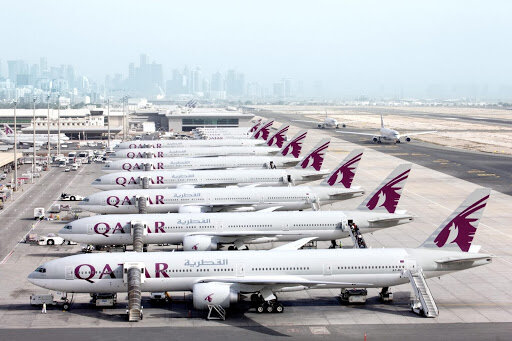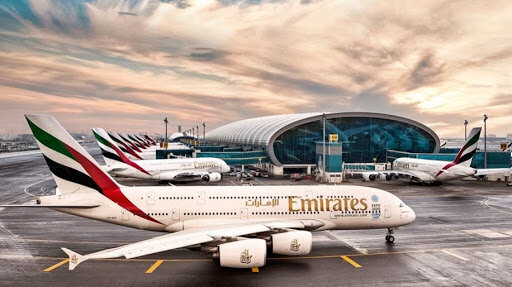Hamad’s Rebirth: Qatar Airways’ Way Back to “the Best”
Qatar Airways gradually resumes its international flights from its Doha home base, Hamad International Airport. (Source: Middle East Monitor)
It’s been 80 days since Winnie Chiang hadn’t worked on board. But this time, she is asked to wear a protective coverall outside of her purplish-red uniform.
To deliver services under the unique two-layer uniform is hard. “But my supervisor continuously reminds us to keep serving customers in five-star standards as usual,” says Chiang. “We have to be the best.”
Chiang is a cabin crew member in Qatar Airways. “Together with the 4-phases resume plan, we are going to resume more routes. To us cabin crews, that’s not a bad thing. But we are asked to wear a protective coverall, and such precautions might be a new routine in the future. It’s quite uncomfortable, but we have no choice.”
On Jun. 15, the Supreme Committee for Crisis Management released the 4-phases plan to lift the COVID-19 restrictions in Qatar. As a national symbol of the small gulf country, Qatar Airways and its base camp, Hamad International Airport, successively moved forward their steps to reopen more services, including more resumed routes and returning employees.
However, like how Chiang describes her future working condition as “not bad, uncomfortable, but no more choices” under the global pandemic, Qatar Airways also confronts a future business blueprint with entangled unavoidable negative impacts and not-bads.
“Together with the 4-phases resume plan, we are going to resume more routes. To us cabin crews, that’s not a bad thing. But we are asked to wear a protective coverall, and such precautions might be a new routine in the future. It’s quite uncomfortable, but we have no choice.”
One of the enormous changes is upon its future orders from Boeing and Airbus. In an interview conducted by Sky News, Qatar Airways’ Chief Executive Officer Akbar al-Baker indicated that Qatar Airways would defer “quite a lot of [deliveries]” from the world’s two biggest plane makers. Al-Baker’s company will not make any new orders from Boeing or Airbus until 2021. “All the other aircraft that we have on order that was supposed to be delivered to us within the next two or three years will now be pushed back to as long as nearly eight to 10 years,” al-Baker added.
It is quite unusual for this dominant Middle Eastern airline because in the past, Qatar Airways was famous for complaining about plane makers’ delayed deliveries impacting its ambitious expansion. This time, the situation has been reversed: although the company released its intention to retire all the Boeing 777-300ER before 2024 for the upcoming 777Xs order (including 10 Boeing 777-8s and 50 Boeing 777-9s) a week later, it is still crystal-clear that the Qatari giant will slow down its expansion steps at least in the following two to three years.
Indeed, the entire industry is undergoing a severely cold winter due to COVID-19. Qatar Airways has never quitted the regional hot war with its two Emirati competitors, Fly Emirates and Etihad. Unlike the United Arab Emirates, which temporarily closed some of its airports in late March, the Qatari giant tried hard to maintain Hamad International Airport’s operation even during the worst time.
Emirates grounded its world’s largest A380s fleet from March and will resume some of its A380s in July. (Source: Simple Flying)
The distinctive aircraft operation strategies between Qatar Airways and the Emirati competitors have also made them react differently during —and maybe even after— the pandemic. With the massive decline of attendance, especially to the large-size aircraft, Emirates grounded its world’s largest A380s fleet from March. However, Qatar Airways favors mid-size aircraft such as 787s and A350s, especially for its Middle Eastern and European routes. While encountering the declined attendance and expectedly decreasing frequencies, its loss has been smaller. Also, in the post-COVID era, Qatar Airways might become the one leading the industrial recovery; its Chief Strategy and Transformation Officer, Thierry Antinori, said to Forbes that “[with the smaller widebodies’ fleet and premium onboard products,] we see the opportunity at Qatar Airways to take a higher share of the corporate and business.” After Airbus stopped the production of A380 last, Emirates belatedly realized the importance of a smaller widebodies fleet. But the A350s’ and 787s’ deliveries won’t settle down until 2023. In the post-COVID era competition, Emirates has already lost the exceptional opportunities in the game with Qatar Airways.
Apart from the “better combination of the fleet,” Qatar Airways has also diverted more efforts into the cargo service when the winter began. On Mar. 30, it resumed belly-hold cargo operations to six destinations in Mainland China, whose airports have not hosted those Middle Eastern aircraft for two months. Under the previously assigned flight numbers and frequencies, these flights transport urgent medical aids that are pivotal to fight against the global COVID-19 pandemic. Until now, Qatar Airways has developed 60 freighter destinations and more than 160 passenger destinations worldwide via its Doha hub. In comparison, Emirates’ SkyCargo merely has around 60 destinations and utilizes passenger aircraft for extra cargo capacity.
In short, Qatar Airways indeed has experienced a considerable loss, including the local markets and transport routes, thanks to a three-year-long blockade in which Saudi Arabia, the UAE, Bahrain, and Egypt have closed their airspace to Qatar Airways since 2017. Nevertheless, under the global pandemic, Qatar Airways’ better fleet strategies and timely business alternatives upon cargo services have helped it to complete a temporary corner overtaking in the competition with the two Emirati giants.
In the long run, the race between these Middle Eastern airlines will continue, in terms of the everlasting business competitions and the geopolitical tensions in the Gulf. To Qatar Airways itself and its thousands of employees such as Chiang, it is also bound to an unprecedentedly hard year to defend its title as “the World’s Best” crown.


